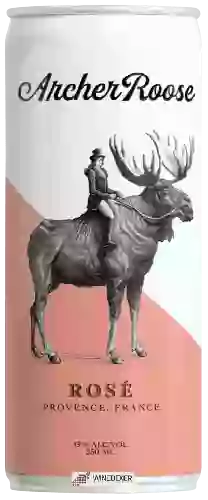
Winery Archer RooseRosé
In the mouth this pink wine is a with a nice freshness.
This wine generally goes well with pork, vegetarian or poultry.
Taste structure of the Rosé from the Winery Archer Roose
Light | Bold | |
Dry | Sweet | |
Soft | Acidic |
In the mouth the Rosé of Winery Archer Roose in the region of Provence is a with a nice freshness.
Wine flavors and olphactive analysis
On the nose the Rosé of Winery Archer Roose in the region of Provence often reveals types of flavors of strawberries, tree fruit or red fruit.
Food and wine pairings with Rosé
Pairings that work perfectly with Rosé
Original food and wine pairings with Rosé
The Rosé of Winery Archer Roose matches generally quite well with dishes of pork, shellfish or vegetarian such as recipes of pork gyros, mussels spanish style or ham and comté quiche.
Details and technical informations about Winery Archer Roose's Rosé.
Discover the grape variety: Cinsault
Cinsaut noir is a grape variety that originated in France (Provence). It produces a variety of grape specially used for wine making. It is rare to find this grape to eat on our tables. This variety of grape is characterized by large bunches and large grapes. Cinsaut noir can be found in several vineyards: South-West, Cognac, Bordeaux, Provence & Corsica, Rhône valley, Languedoc & Roussillon, Loire valley, Savoie & Bugey, Beaujolais, Armagnac.
Last vintages of this wine
The best vintages of Rosé from Winery Archer Roose are 2017, 2018
Informations about the Winery Archer Roose
The Winery Archer Roose is one of of the world's greatest estates. It offers 9 wines for sale in the of Coteaux d'Aix-en-Provence to come and discover on site or to buy online.
The wine region of Coteaux d'Aix-en-Provence
Côteaux d'Aix-en-Provence is one of the main French appellations in the Provence wine region, located in the extreme southeast of the country. It is the second largest appellation in the region, with about 4,000 hectares North and west of Aix-en-Provence - the town from which it takes its name. The area also bears the tiny title of AOCPalette. The Côteaux d'Aix-en-Provence appellation was first introduced as a VDQS in 1956, having been informally known as Côteaux du Roy René (René d'Anjou being a 15th century French king famous for his love of wine and the Vine).
The wine region of Provence
Provence is a wine region in the far southeast of France, best known for the quality (and quantity) of its rosé wines and for its Warm, mild Climate. The modernization that is taking place in many of the traditional wine regions of southern France has not yet taken place to the same extent in Provence, but there are Clear signs of change. The region's Grape varieties, in particular, have come under scrutiny in recent decades. Traditional varieties such as Carignan, Barbaroux (Barbarossa from Sardinia) and Calitor are being replaced by more commercially viable varieties such as Grenache, Syrah and even Cabernet Sauvignon.
News related to this wine
Chablis: #locationmatters by Yang LU
On December 10, 2020, four Hong Kong personalities discussed Chablis wines on a live webinar: Yang LU, Master Sommelier and Official Bourgogne Wines Ambassador, Debra MEIBURG, Master of Wine, Ivy NG, Official Bourgogne Wines Ambassador and Rebecca LEUNG, wine expert. In this first 90-second clip, Yang LU explains how location is the key to understanding “Why Chablis is special”. #Chablis #PureChablis ...
The Irancy appellation seen by Nicolas Ferrari
Nicolas Ferrari, from Domaine Ferrari, explains how the Irancy Village appellation has been created over the years. He also reveal the ageing capacity of the appellation and invites us to be patient “ Our patience is always rewarded with an Irancy”. This video is taken from the “Rendez-vous avec les vins de Bourgogne” program (June 2020). Our social media: Facebook: https://www.facebook.com/BourgogneWines Twitter: https://twitter.com/BourgogneWines/ Instagram: https://www.instagram.com/vin ...
The Mâcon plus appellation investigated through its geology and geography
The Bourgogne Wine Board (BIVB) invites you to enjoy this video in which Jean-Pierre Renard, Expert Instructor at the Ecole des Vins de Bourgogne, explains the topographical and geological characteristics of the appellation Mâcon plus geographical denomination . The tectonics and the very different nature of the rocks that make up the subsoil of this region explain the great variety of soils found in this part fo Bourgogne. It also explains why each wine offers a different personnality. This vid ...
The word of the wine: Naturé
See savagnin.














